Abstract
1. In studies of rabbit airway smooth muscle, differences in mechanical responses to acetylcholine, histamine and high K+ in intact muscles, and in Ca2+ sensitivity in skinned muscles, have been examined in tissue taken from 5 different regions of the airway. Interactions between prostaglandin F2 alpha and epithio-thromboxane A2 and the above spasmogenic agencies were also studied. 2. Mechanical responses to histamine (10 microM) and to 128 mM K+ were smallest in trachea and were largest in 3rd and 4th order bronchi. In all regions, spasm evoked by 10 microM acetylcholine was greater than that evoked by 10 microM histamine or 128 mM K+. 3. In the third and fourth branches of the rabbit right middle bronchus, contractions evoked by 10 microM acetylcholine, 10 microM histamine and 128 mM K+ showed similar amplitudes of phasic response. In Ca2+-free solution containing 2 mM EGTA, the phasic components of the acetylcholine- or histamine-induced contraction remained unchanged in comparison with that observed in Krebs solution, but the phasic and tonic components of the K+-induced contraction and the tonic changes induced by acetylcholine and histamine were abolished. 4. Two subtypes of the histamine receptor, excitatory H1- and inhibitory H2- receptors were detected on the bronchial smooth muscle. The H1-induced contraction was mediated by release of stored Ca2+ together with activation of Ca2+ influx relatively insensitive to Ca2+ antagonists. 5. The -log(EC50) values for acetylcholine and histamine (in the presence of cimetidine and atropine) were 6.11 +/- 0.11 and 5.33 +/- 0.08, respectively, in the third branch of right middle bronchus. These values were similar to those observed for trachea.(ABSTRACT TRUNCATED AT 250 WORDS)
Full text
PDF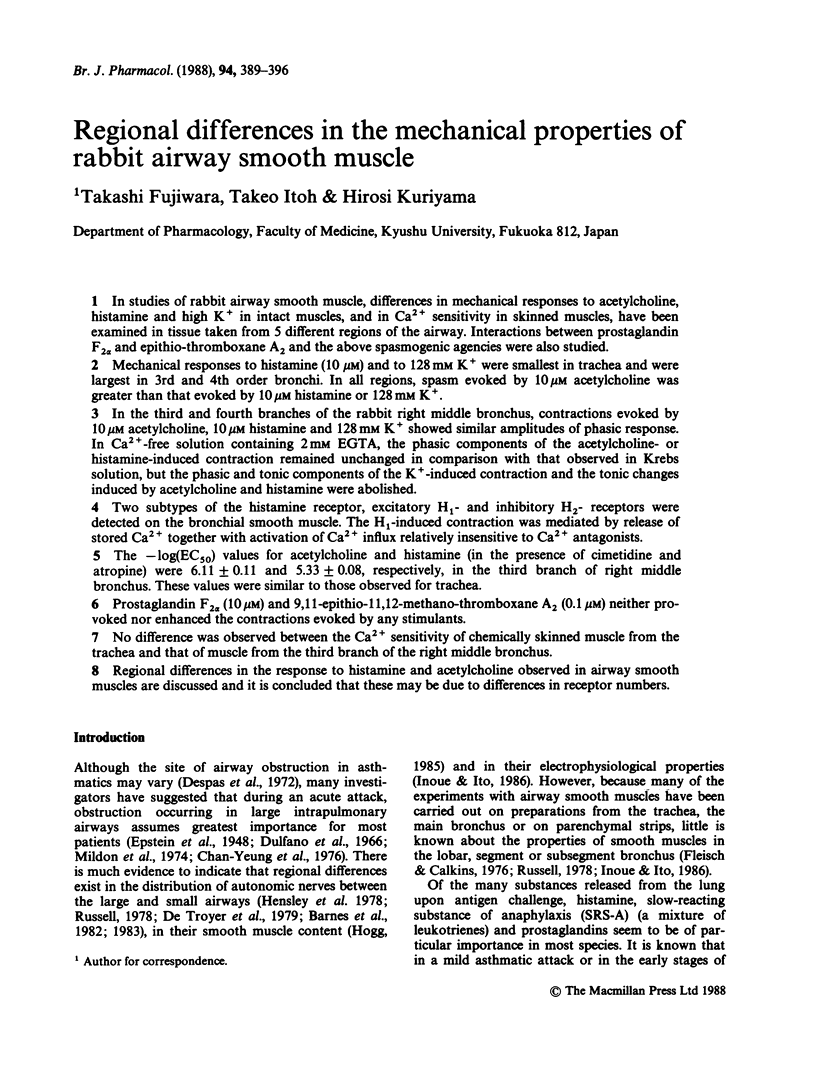
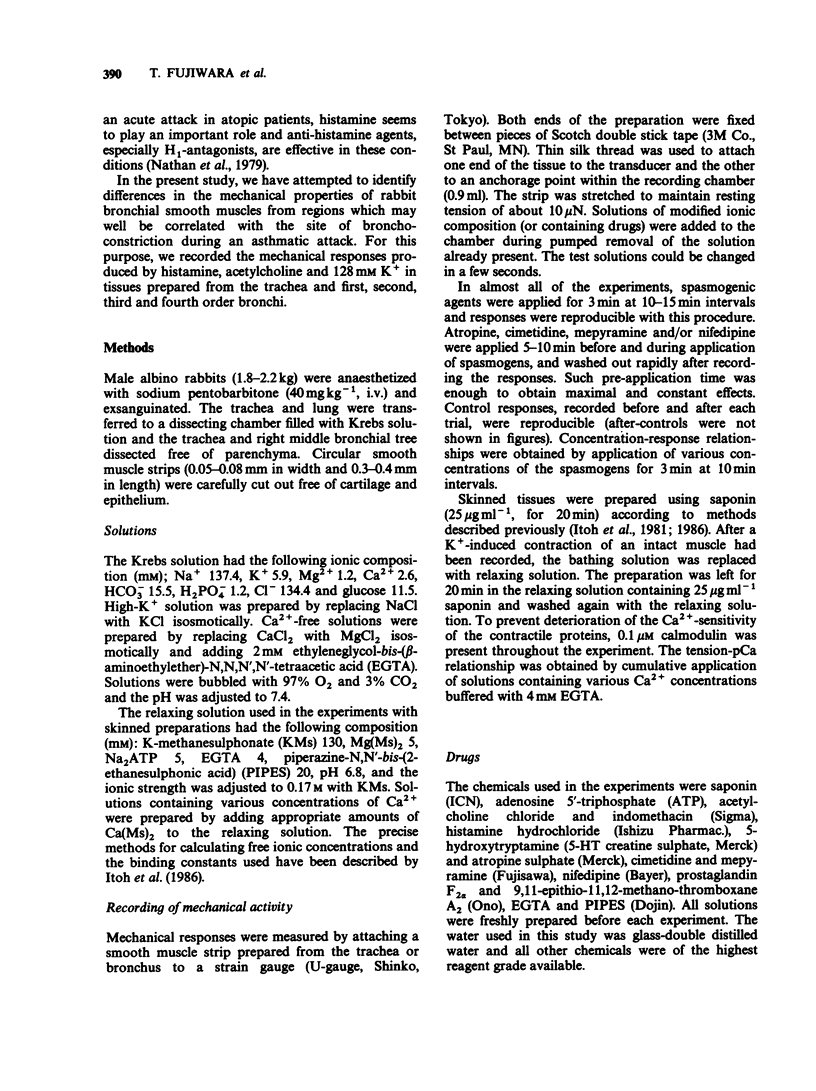
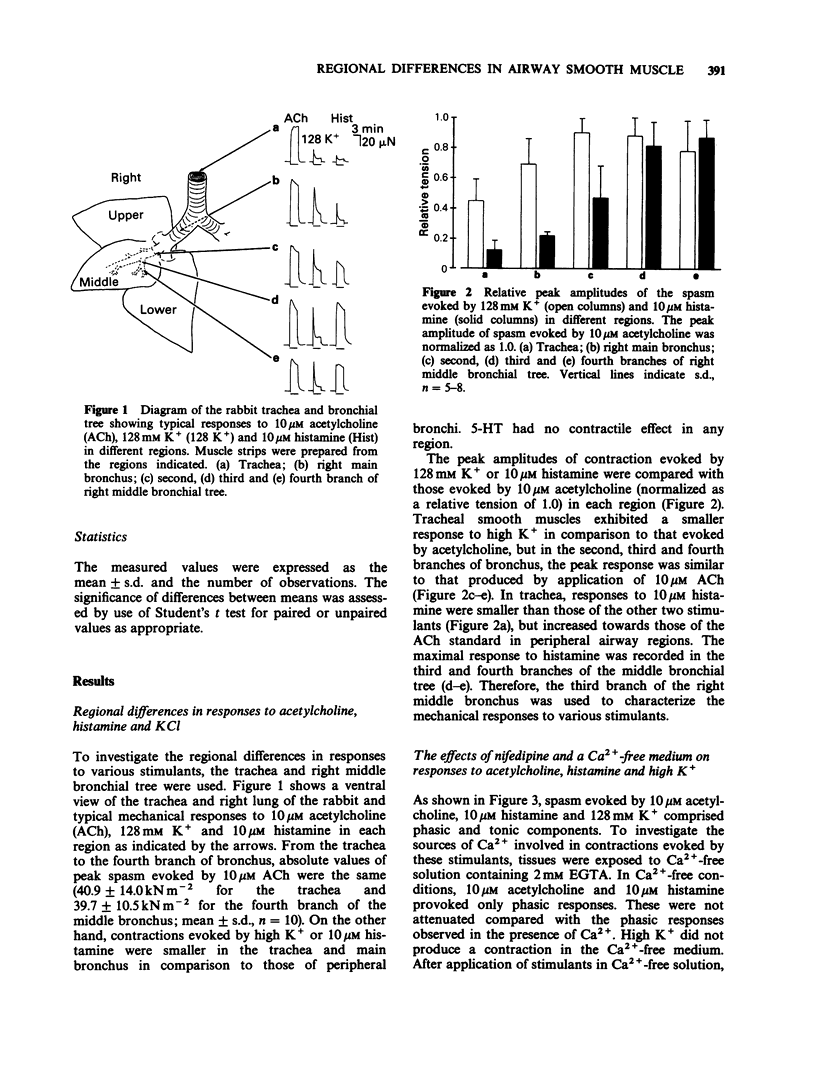
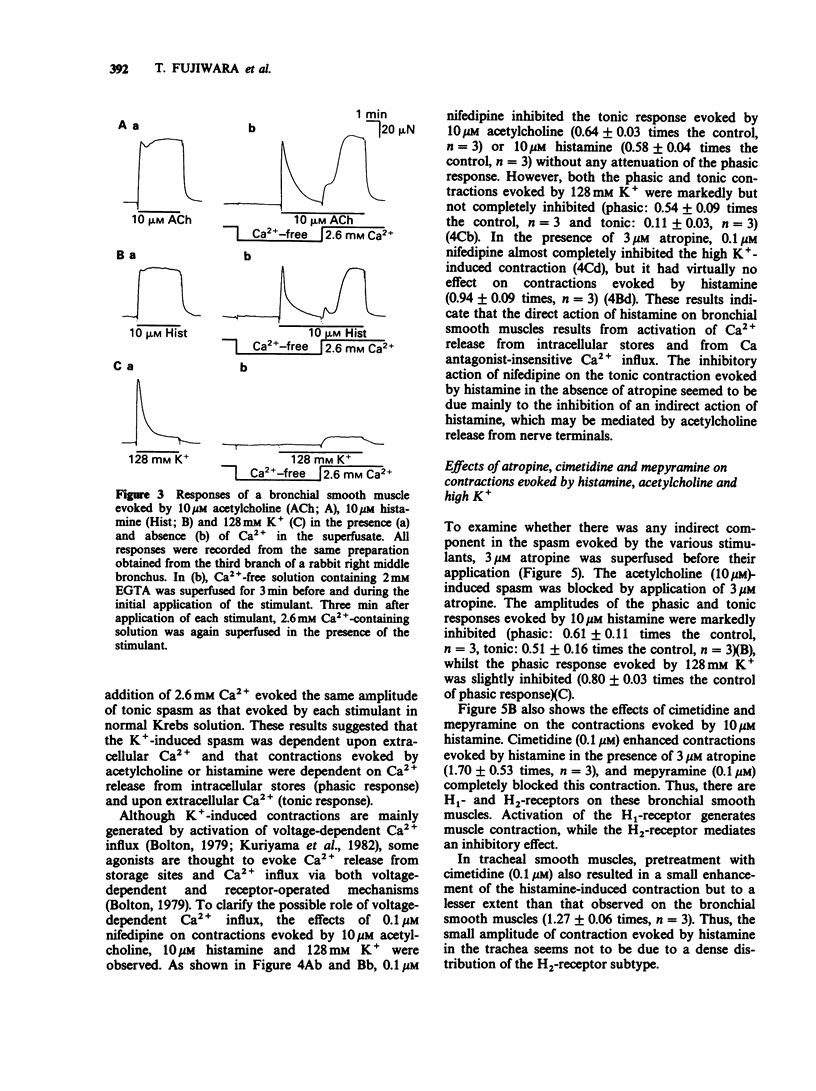
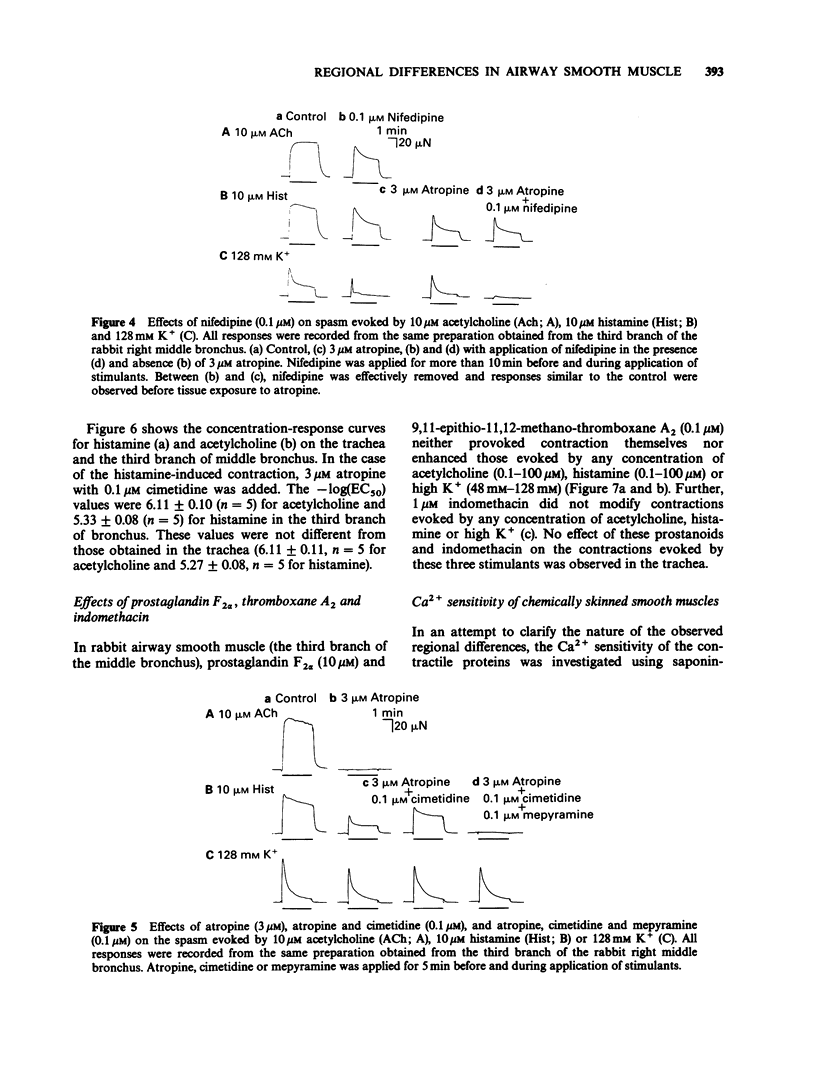
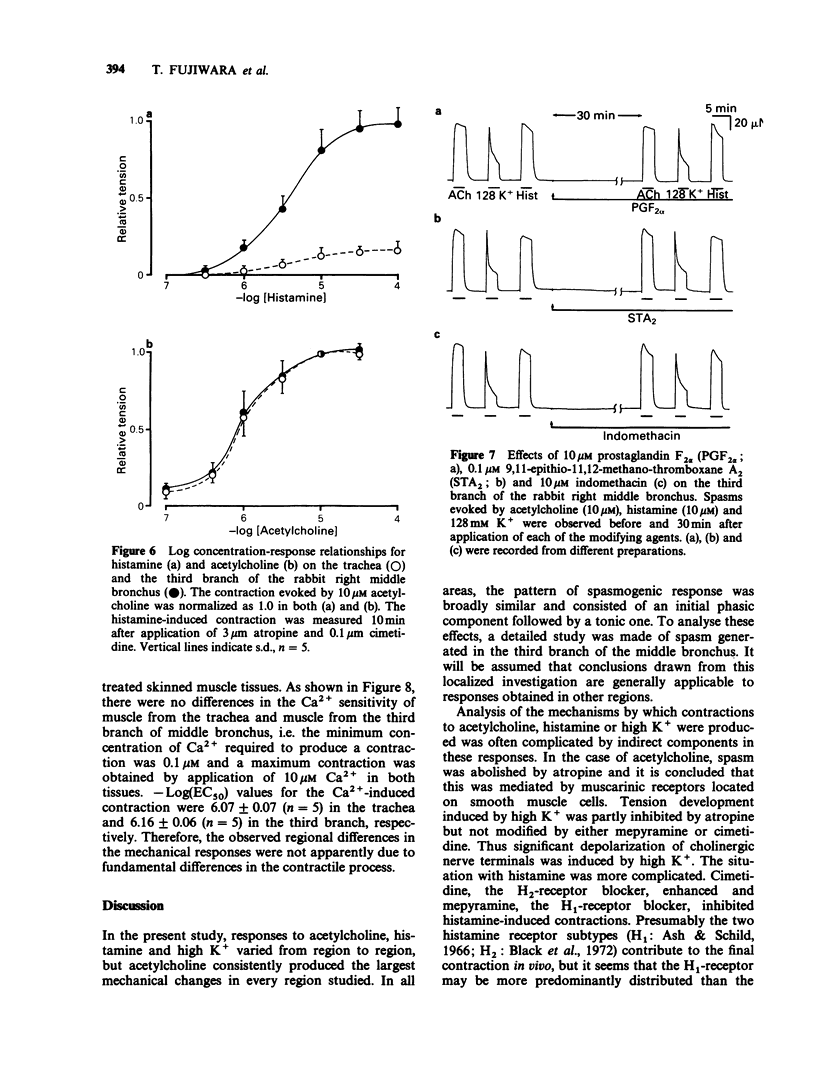

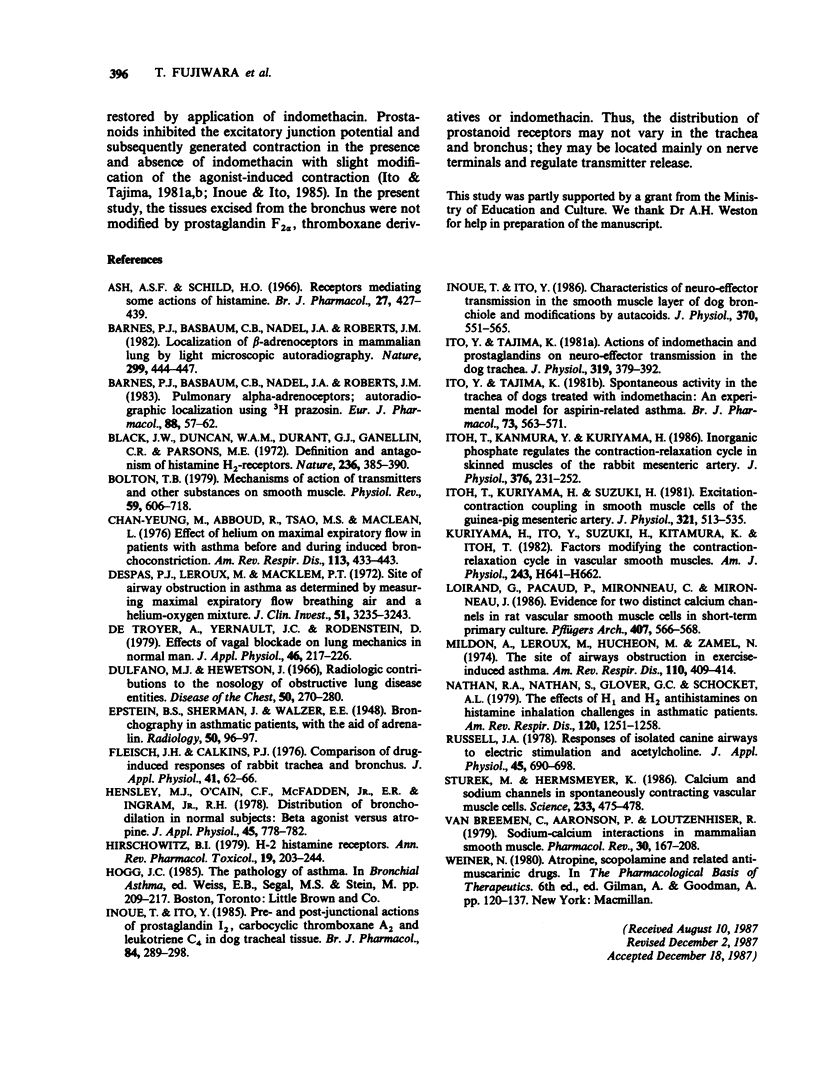
Selected References
These references are in PubMed. This may not be the complete list of references from this article.
- Ash A. S., Schild H. O. Receptors mediating some actions of histamine. Br J Pharmacol Chemother. 1966 Aug;27(2):427–439. doi: 10.1111/j.1476-5381.1966.tb01674.x. [DOI] [PMC free article] [PubMed] [Google Scholar]
- Barnes P. J., Basbaum C. B., Nadel J. A., Roberts J. M. Localization of beta-adrenoreceptors in mammalian lung by light microscopic autoradiography. Nature. 1982 Sep 30;299(5882):444–447. doi: 10.1038/299444a0. [DOI] [PubMed] [Google Scholar]
- Barnes P. J., Basbaum C. B., Nadel J. A., Roberts J. M. Pulmonary alpha-adrenoceptors: autoradiographic localization using [3H]prazosin. Eur J Pharmacol. 1983 Mar 18;88(1):57–62. doi: 10.1016/0014-2999(83)90391-6. [DOI] [PubMed] [Google Scholar]
- Black J. W., Duncan W. A., Durant C. J., Ganellin C. R., Parsons E. M. Definition and antagonism of histamine H 2 -receptors. Nature. 1972 Apr 21;236(5347):385–390. doi: 10.1038/236385a0. [DOI] [PubMed] [Google Scholar]
- Bolton T. B. Mechanisms of action of transmitters and other substances on smooth muscle. Physiol Rev. 1979 Jul;59(3):606–718. doi: 10.1152/physrev.1979.59.3.606. [DOI] [PubMed] [Google Scholar]
- Chan-Yeung M., Abboud R., Tsao M. S., Maclean L. Effect of helium on maximal expiratory flow in patients with asthma before and during induced bronchoconstriction. Am Rev Respir Dis. 1976 Apr;113(4):433–443. doi: 10.1164/arrd.1976.113.4.433. [DOI] [PubMed] [Google Scholar]
- De Troyer A., Yernault J. C., Rodenstein D. Effects of vagal blockade on lung mechanics in normal man. J Appl Physiol Respir Environ Exerc Physiol. 1979 Feb;46(2):217–226. doi: 10.1152/jappl.1979.46.2.217. [DOI] [PubMed] [Google Scholar]
- Despas P. J., Leroux M., Macklem P. T. Site of airway obstruction in asthma as determined by measuring maximal expiratory flow breathing air and a helium-oxygen mixture. J Clin Invest. 1972 Dec;51(12):3235–3243. doi: 10.1172/JCI107150. [DOI] [PMC free article] [PubMed] [Google Scholar]
- Dulfano M. J., Hewetson J. Radiologic contributions to the nosology of obstructive lung disease entities. Dis Chest. 1966 Sep;50(3):270–280. doi: 10.1378/chest.50.3.270. [DOI] [PubMed] [Google Scholar]
- Fleisch J. H., Calkins P. J. Comparison of drug-induced responses of rabbit trachea and bronchus. J Appl Physiol. 1976 Jul;41(1):62–66. doi: 10.1152/jappl.1976.41.1.62. [DOI] [PubMed] [Google Scholar]
- Hensley M. J., O'Cain C. F., McFadden E. R., Jr, Ingram R. H., Jr Distribution of bronchodilatation in normal subjects: beta agonist versus atropine. J Appl Physiol Respir Environ Exerc Physiol. 1978 Nov;45(5):778–782. doi: 10.1152/jappl.1978.45.5.778. [DOI] [PubMed] [Google Scholar]
- Hirschowitz B. I. H-2 histamine receptors. Annu Rev Pharmacol Toxicol. 1979;19:203–244. doi: 10.1146/annurev.pa.19.040179.001223. [DOI] [PubMed] [Google Scholar]
- Inoue T., Ito Y. Characteristics of neuro-effector transmission in the smooth muscle layer of dog bronchiole and modifications by autacoids. J Physiol. 1986 Jan;370:551–565. doi: 10.1113/jphysiol.1986.sp015950. [DOI] [PMC free article] [PubMed] [Google Scholar]
- Inoue T., Ito Y. Pre- and post-junctional actions of prostaglandin I2, carbocyclic thromboxane A2 and leukotriene C4 in dog tracheal tissue. Br J Pharmacol. 1985 Feb;84(2):289–298. doi: 10.1111/j.1476-5381.1985.tb12913.x. [DOI] [PMC free article] [PubMed] [Google Scholar]
- Ito Y., Tajima K. Actions of indomethacin and prostaglandins on neuro-effector transmission in the dog trachea. J Physiol. 1981;319:379–392. doi: 10.1113/jphysiol.1981.sp013915. [DOI] [PMC free article] [PubMed] [Google Scholar]
- Ito Y., Tajima K. Spontaneous activity in the trachea of dogs treated with indomethacin: an experimental model for aspirin-related asthma. Br J Pharmacol. 1981 Jun;73(2):563–571. doi: 10.1111/j.1476-5381.1981.tb10456.x. [DOI] [PMC free article] [PubMed] [Google Scholar]
- Itoh T., Kanmura Y., Kuriyama H. Inorganic phosphate regulates the contraction-relaxation cycle in skinned muscles of the rabbit mesenteric artery. J Physiol. 1986 Jul;376:231–252. doi: 10.1113/jphysiol.1986.sp016151. [DOI] [PMC free article] [PubMed] [Google Scholar]
- Itoh T., Kuriyama H., Suzuki H. Excitation--contraction coupling in smooth muscle cells of the guinea-pig mesenteric artery. J Physiol. 1981 Dec;321:513–535. doi: 10.1113/jphysiol.1981.sp014000. [DOI] [PMC free article] [PubMed] [Google Scholar]
- Kuriyama H., Ito Y., Suzuki H., Kitamura K., Itoh T. Factors modifying contraction-relaxation cycle in vascular smooth muscles. Am J Physiol. 1982 Nov;243(5):H641–H662. doi: 10.1152/ajpheart.1982.243.5.H641. [DOI] [PubMed] [Google Scholar]
- Mildon A., Leroux M., Hutcheon M., Zamel N. The site of airways obstruction in exercise-induced asthma. Am Rev Respir Dis. 1974 Oct;110(4):409–414. doi: 10.1164/arrd.1974.110.4.409. [DOI] [PubMed] [Google Scholar]
- Nathan R. A., Segall N., Glover G. C., Schocket A. L. The effects of H1 and H2 antihistamines on histamine inhalation challenges in asthmatic patients. Am Rev Respir Dis. 1979 Dec;120(6):1251–1258. doi: 10.1164/arrd.1979.120.6.1251. [DOI] [PubMed] [Google Scholar]
- Russell J. A. Responses of isolated canine airways to electric stimulation and acetylcholine. J Appl Physiol Respir Environ Exerc Physiol. 1978 Nov;45(5):690–698. doi: 10.1152/jappl.1978.45.5.690. [DOI] [PubMed] [Google Scholar]
- Sturek M., Hermsmeyer K. Calcium and sodium channels in spontaneously contracting vascular muscle cells. Science. 1986 Jul 25;233(4762):475–478. doi: 10.1126/science.2425434. [DOI] [PubMed] [Google Scholar]
- Van Breemen C., Aaronson P., Loutzenhiser R. Sodium-calcium interactions in mammalian smooth muscle. Pharmacol Rev. 1978 Jun;30(2):167–208. [PubMed] [Google Scholar]


